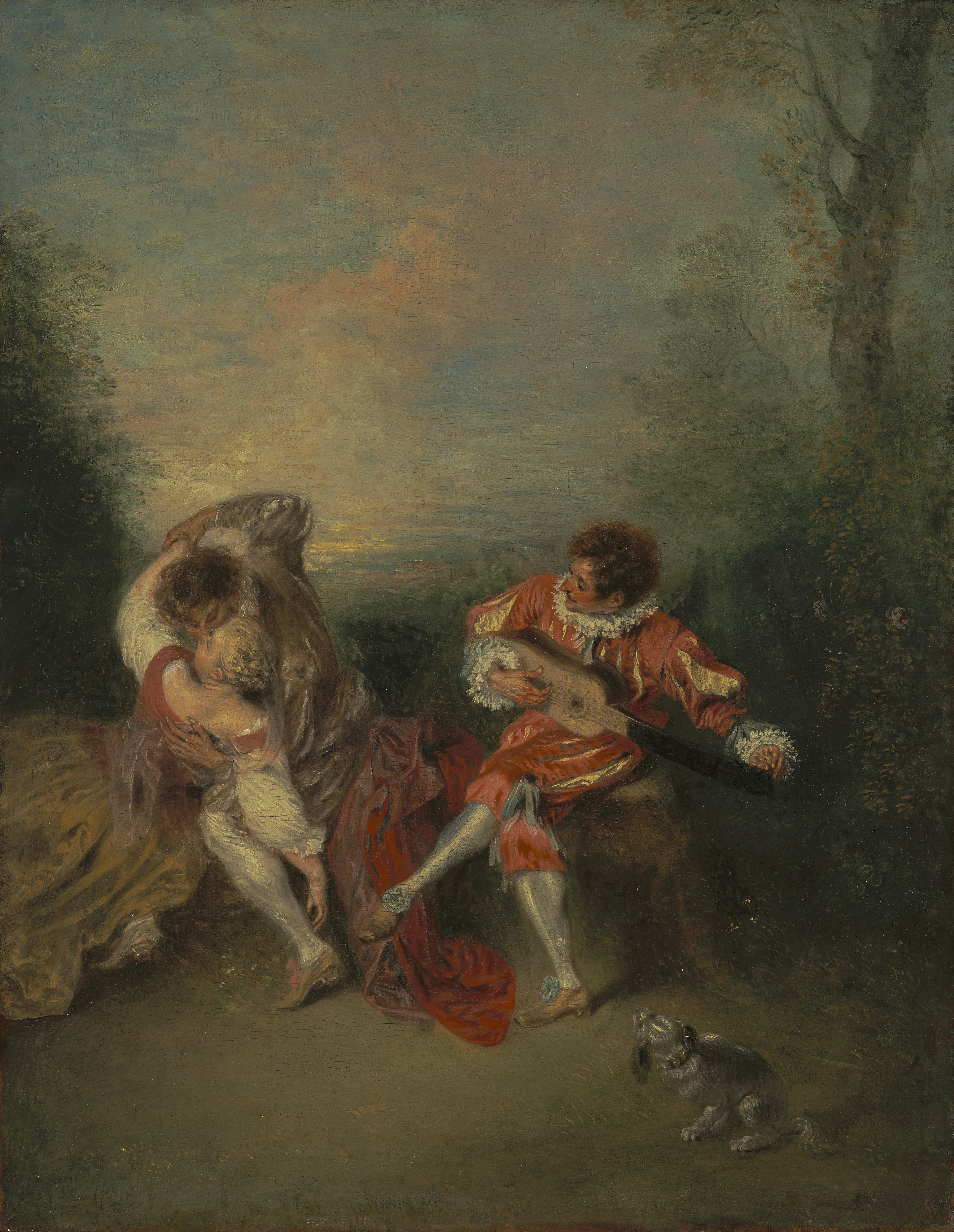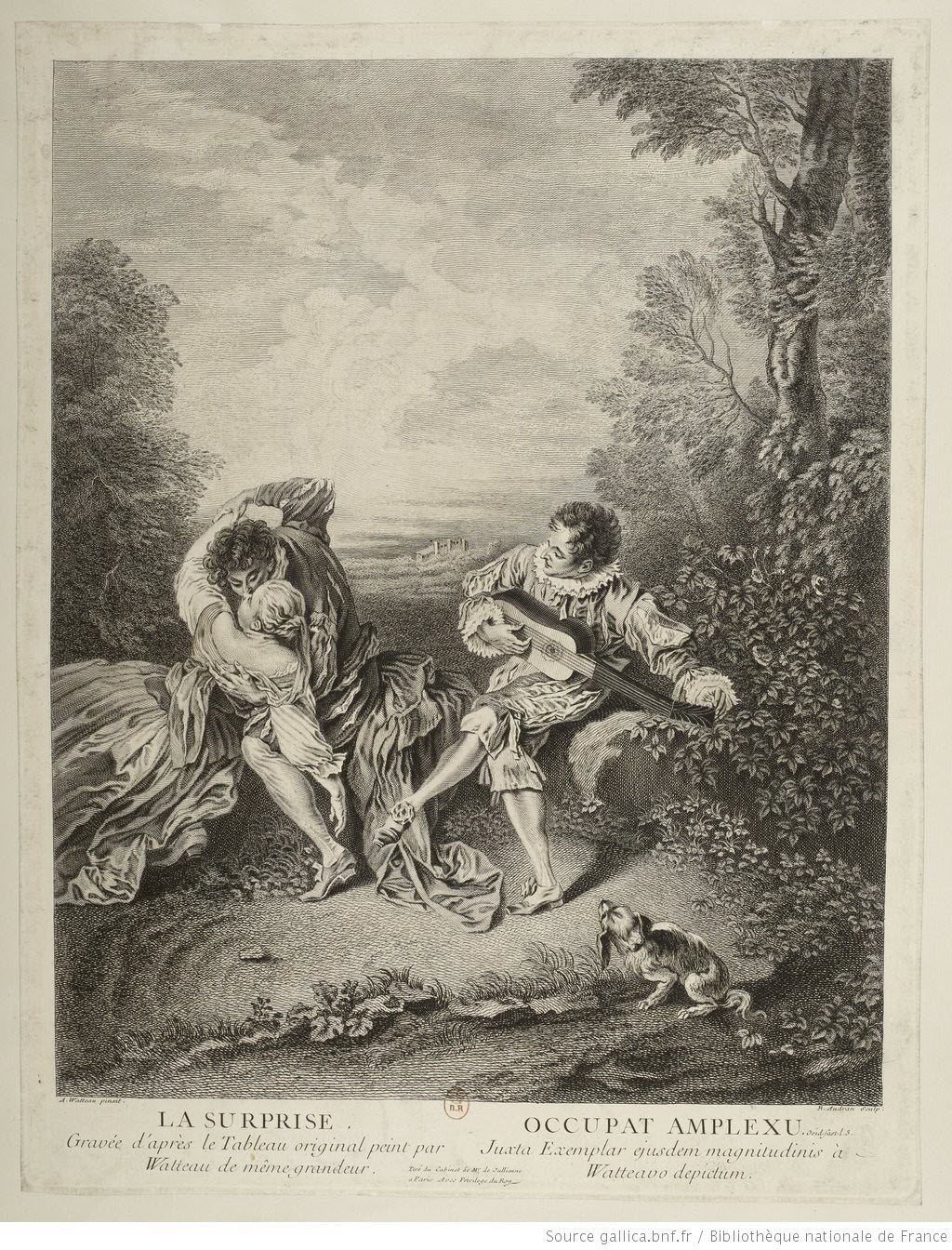
La Suprise was already famous in the eighteenth
century: one of the greatest connoisseurs of the age,
Pierre Jean Mariette (1694–1774), described it around 1746
as “one of his [Watteau’s] finest paintings.”
1
Before its rediscovery in 2008,2
the existence of the picture was well known to
specialists, thanks mainly to an engraving by Benoit II
Audran that appeared in 1731 (fig. 1),3
later included in the famous Recueil Jullienne, a
nearly complete compendium of Watteau’s paintings
published in two volumes in 1735 by his great friend, Jean
de Jullienne (1686–1766), who put together a vast
collection of Watteau’s works after his death.4
La Surprise was also previously known from a copy
on canvas, preserved since 1819 in the British Royal
Collection and sometimes presented as an original.5
Composition, Sources of Inspiration, Execution
As is often the case in Watteau’s works, the subject of the painting is vague and ambiguous, allusive and seductive, and as such is the epitome of the new genre of the fête galante, which he had invented. The figures of the three protagonists are set against the background of a wonderfully atmospheric landscape, illuminated by the warm light of sunset. Our attention is immediately drawn to the pair of young lovers on the left, almost at the edge of the composition, caught in a voluptuous, sensual embrace that seems to echo a dance movement. Completely enthralled in their swirling clutch, they seem oblivious to the presence of a third figure sitting next to them on a rocky outcrop. This is Mezzetin, a traditional character from Italian commedia dell’arte, and a recurring presence in Watteau’s paintings. Dressed in his elegant pink and yellow silk costume with blue ribbons, he is tuning his guitar, while casting an intrigued glance at the lovers. The small dog in the bottom right also seems to share the same sense of surprise and curiosity at the love scene he is unexpectedly witnessing. Like a precious distillate, the small painting seems to condense many of the typical elements of Watteau’s poetics: the celebration of nature, music, and love in a peerless mixture of the real and the artificial, humor and seriousness, melancholy and sensuality.6
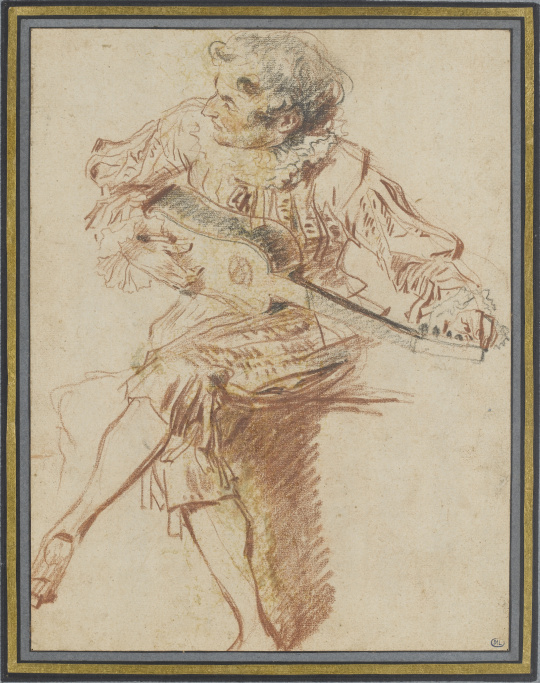
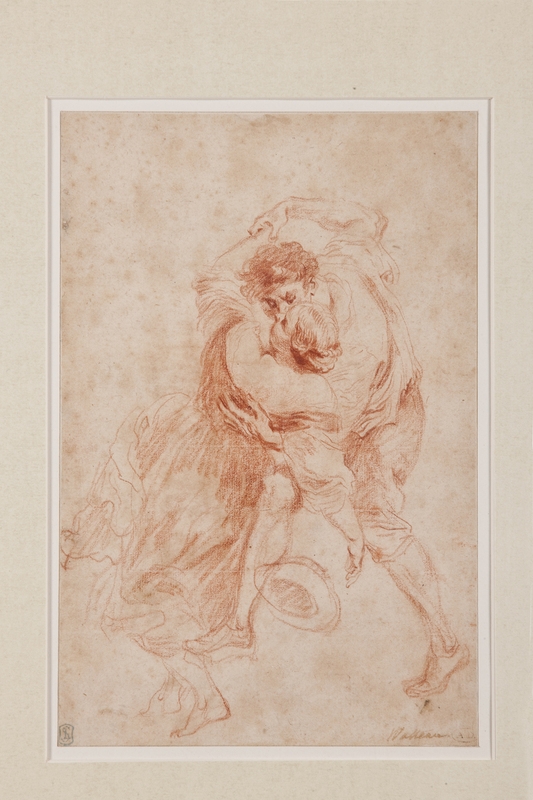
Thanks to two surviving drawings, we are in the fortunate position of being able to take a close look at Watteau’s peculiar approach to composition, a process well described by the Comte de Caylus (1692–1765) in his intelligent biography of the artist in the mid-eighteenth century:
There was no purpose to [Watteau’s] drawing; he never made sketches or notations of even the slightest and most indefinite kind for his pictures. He normally made his studies in a bound book so always to have a large number at hand. […] When he wanted to paint a picture, he could be sure of finding in his book things that he had already approved and would make groups out of them, usually matching them to a landscape that he had conceived or prepared.7
In preparing La Surprise, Watteau turned to his collection of drawings, specifically a vigorous red and black chalk drawing for the figure of Mezzetin today in the Louvre (fig. 2),8 and a wonderful red chalk drawing for the pair of lovers in the Musée des Arts Décoratifs, Paris (fig. 3).9 The Louvre drawing of Mezzetin is undoubtedly a life study of a posed model, dressed in a costume that probably belonged to Watteau himself. The artist used this study some years earlier in his paintings, such as the small Donneur de Sérénades (The Serenader) in the Musée Condé, Chantilly, and later for the figure of the guitarist in the Réunion en plen air (Conversation in the Open Air) in the Gemäldegalerie, Dresden. The careful depiction of the guitar undoubtedly reflects his direct knowledge of a model developed by the Voboam family of luthiers, active in Paris between 1650 and 1730.10 The drawing for the pair of lovers, on the other hand, replicates a detail of a large painting by Peter Paul Rubens (1577–1640), La Kermesse (The Village Wedding) (fig. 4). Watteau must have carefully studied this work, which had entered the collections of Louis XIV in 1685. What surely attracted him to Rubens’s young country couple was the swirling centrifugal movement and sensual energy.11 First in the drawing, then in the painting, however, Watteau transfigured his model into something instantly recognizable as his own. As Svetlana Alpers has pointed out, “the physical exertion of the dance, emphasized by Rubens through the sheer weight of the woman whom the young man so energetically supports, is transformed—despite the rough kiss—into a pattern. The bodily contact is replaced by a suggestion of fragile social interplay [.…] Embracing on a grassy bank, the couple is now fit company for the music of the courtly guitar rather than the rustic bagpipe, and a dog rather than a pig is the appropriate attendant animal.”12 We know that during his training with Claude III Audran, Watteau had direct access to the grandiose cycle that Rubens had been commissioned to paint for the Palais du Luxembourg by Marie de’ Medici almost a century earlier: thus, for example, the dog in the foreground of La Surprise is a reversed quotation of the dog that appears in Rubens’s The Marriage by Proxy of Marie de’ Medici to King Henry IV (Paris, Louvre). What drew Watteau to Rubens, however, was not the cultivated painter of complex allegorical compositions but above all the great colorist whose talent had been praised by the French art critic Roger de Piles (1635–1709) in his writings. Watteau was mainly attracted by Rubens’s brilliant brushwork and sumptuous palette, by his vivid portrayal of characters, and by his talent in rendering textures, from the rustle of silk to the consistency of velvet.

If, on the one hand, La Surprise reveals Watteau’s admiration for the Flemish masters—especially Rubens, but also Anthony van Dyck (1599–1641) (Mezzetin’s costume is an explicit homage to the art of Rubens’s brilliant student)—on the other, the specific atmosphere of the composition is a tribute to the great sixteenth-century Venetian school. The Comte de Caylus also mentions that Watteau was able to further his knowledge of Venetian sixteenth-century masters, particularly through the extraordinary collection of paintings and drawings put together by Pierre Crozat (1661–1740): “the fine craftsmanship, the beautiful settings, and the tasteful, lively foliage of the trees by Titian and Campagnola, which he was able to see, thus, as it were unveiled, enchanted him.”13 From some of the drawings in the Crozat collection, especially the pen and ink landscape drawings by Domenico Campagnola (at the time often attributed to Titian), Watteau made faithful copies in a series of splendid red chalk sheets.14 Pierre Rosenberg has stressed the importance of Watteau’s practice of copying the Old Masters. Not having had a traditional “academic” training, his approach was extremely free and selective: he copied “works that pleased him, that inspired him, that appealed to his taste and predilections, works that revealed to him an Italy he would never visit and familiarized him with artists he admired and loved.”15
Once again, as with Rubens, Watteau saw in the Venetian painters a “mood” that was remarkably akin to his own personal artistic vision. A work such as Titian’s Concert Champêtre (now in the Louvre, Paris)—described in 1683 by Charles Le Brun as a Pastorale by Giorgione, and later admired by Crozat—must have been a significant source of inspiration. Watteau was certainly attracted by the mysterious elusiveness of the subject (one with no univocal interpretation), the harmony between man and nature, the preeminent role of the conversation accompanied by music, and the vibrant, soft consistency of the brushstrokes.16
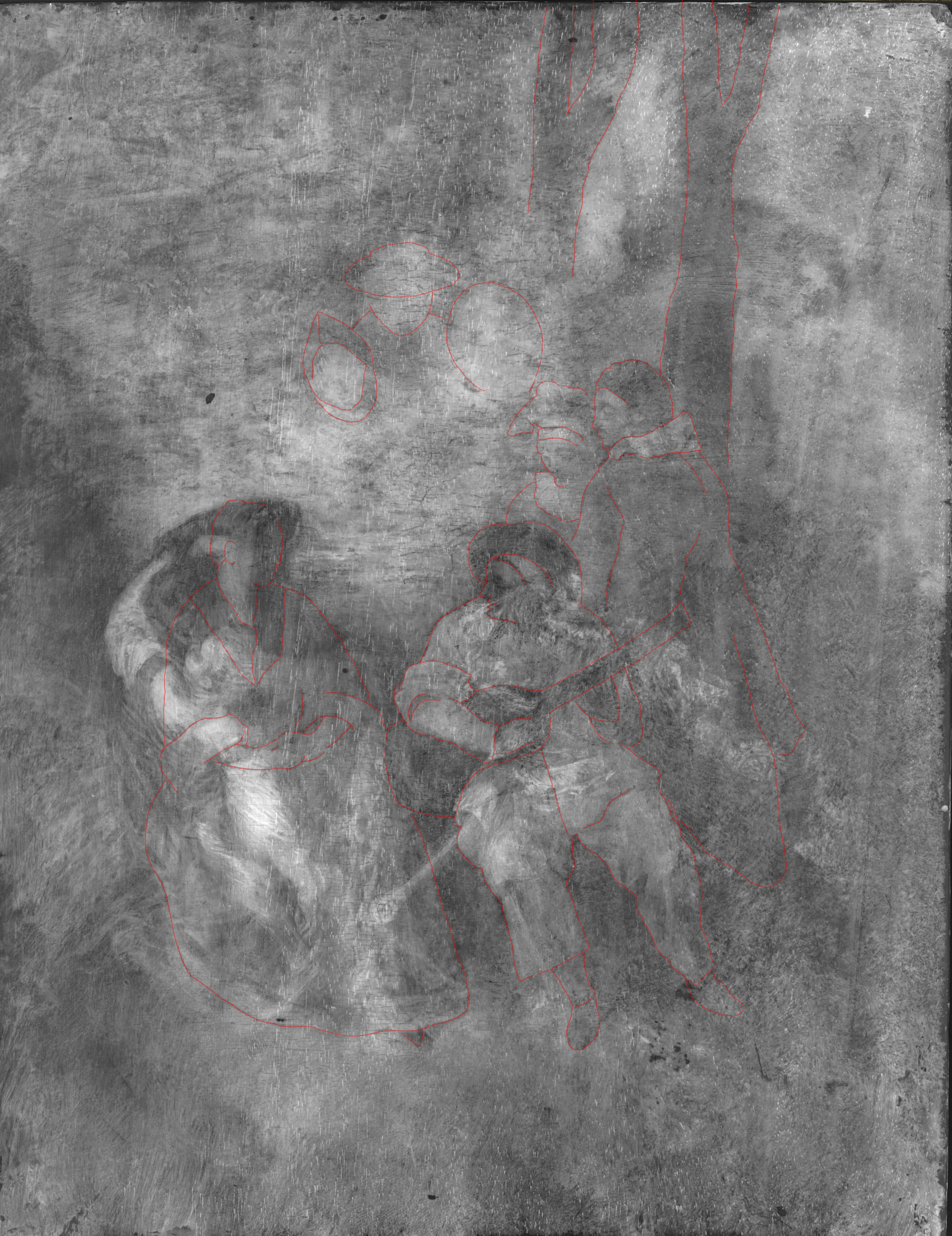
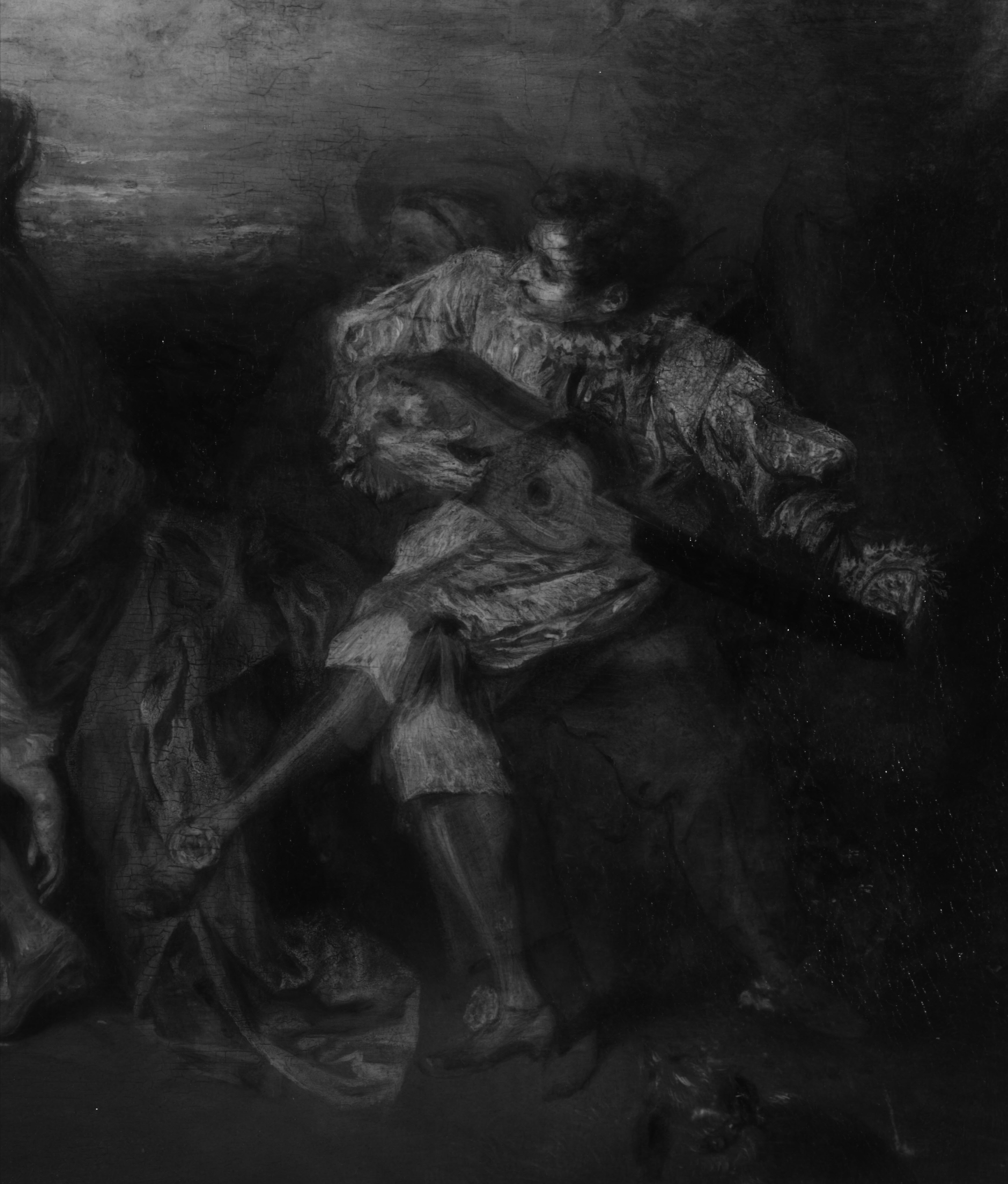
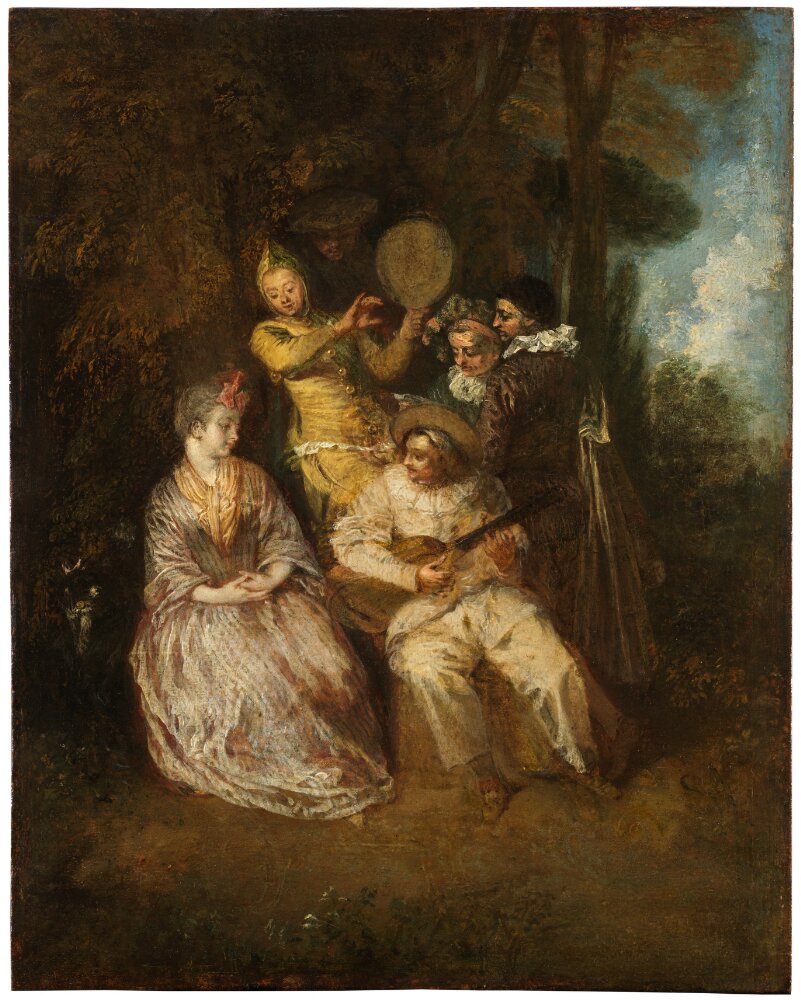
The excellent condition of La Surprise means that
we can fully appreciate its extraordinarily refined
execution, the virtuoso brushwork, and the delicacy of the
glazing, resulting in the hazy quality of the background
landscape, the silky luster of the colors, and the vivid
details of Mezzetin’s elegant costume. The overall result
is that “air piquant et animé” (piquant and lively air)
celebrated by Caylus in the works of Watteau,17
but also in some of the early descriptions of
La Surprise.18
As in many other paintings by Watteau, however, the
apparent immediacy and spontaneity of this painting
conceals a complex, layered execution process. In fact, on
observing the X-radiograph (fig. 5) and the infrared reflectogram of the work (fig. 6), we find that Watteau had originally drafted a
composition that appears to be remarkably similar to that
of La Sérénade italienne (Italian Serenade) in
the Nationalmuseum, Stockholm (fig. 7), a painting from around 1718, and therefore probably
slightly predating La Surprise.19
Indeed, underneath the current composition, we can see a
landscape and six figures that reproduce almost exactly
the Stockholm Sérénade. In the place where
Mezzetin now sits, Pierrot was seated playing the guitar,
while standing behind him were Mezzetin, reading a musical
score, and Crispin, instantly recognizable with his black
skullcap. The other three figures are sketchier but can
still be detected: Columbine seated next to Pierrot, Momus
standing with a tambourine, and the head of an
unidentified figure looking over his shoulder. It is not
known why Watteau initially wished to replicate
La Sérénade italienne, only to invent a
completely new composition. The positioning of the
underlying figures—especially the figure of Pierrot at the
center over which the guitarist Mezzetin is
superimposed—conditioned the new composition, causing the
strange imbalance that appears to be one of the main
features of La Surprise. Significantly,
La Sérénade italienne was also painted on top of
another composition20: the X-ray revealed that underneath the present one
Watteau had originally conceived a composition with only
three figures (Columbine, Pierrot, and Momus). Moreover,
this first version of the Stockholm work was actually
painted on half of a carriage door, already decorated with
heraldic motifs of greyhound and grotesques. What is
intriguing, however, is that on the other half of the same
carriage door Watteau painted
L’Accord parfait
(Perfect Harmony), now in the Los Angeles County Museum of
Art.21
The origin of these three works is therefore curiously,
albeit mysteriously, intertwined. Since
La Sérénade italienne and
L’Accord parfait were painted on the same
carriage door support, sawn into two similar sized panels
(the Stockholm panel measures 33.5 x 27 cm, while the Los
Angeles one is 33 x 27.9 cm), it has been suggested that
they might have been conceived as pendants. But the two
works have never hung together as a matching pair: the
Stockholm painting belonged to Évrard Titon du Tillet
(1677-1762) before 1729, while
L’Accord parfait was paired with
La Surprise in Nicolas Hénin’s collection before
1724. We can imagine, therefore, that, although the
conception and execution of these three works are closely
linked, they reveal Watteau’s habit of recycling and
importing ideas and motifs from one painting to another,
in an endless process of revision and variation on the
same themes. The unusually uniform results—for which he
was reproached by eighteenth-century critics with a
traditional, “academic” point of view (for example, by the
Comte de Caylus)22—enabled collectors to juxtapose works in pairs on the
walls of their apartments in a way not originally
envisaged by the artist.
A celebrated painting and its collecting history
The almost legendary aura of La Surprise was heightened by the fact that it passed through several prestigious collections over the course of the eighteenth century. After Watteau’s death in 1721, it was documented as being in the collection of Nicolas Hénin (1691–1724), one of the artist’s best friends, together with L’Accord parfait, which by a curious twist of fate also recently ended up in California, having been purchased by the Los Angeles County Museum of Art in 1999.23 We do not know whether the two paintings were commissioned by Hénin or inherited by him on the artist’s death, since he was one of Watteau’s heirs. According to Mariette, L’Accord parfait was painted for Hénin and he considered it to be a pendant of La Surprise.24 It is hard to believe, however, that the two works were originally conceived as pendants since visually the two paintings do not make an obvious pair: although the sizes and dates of execution are very similar, the figures in L’Accord parfait are larger, much closer to the foreground, and occupy much of the painted surface, whereas in La Surprise, the figures are smaller, are set in the middle ground, and occupy only part of the overall composition. The juxtaposition of the two paintings, therefore, must not have been envisaged from the outset but was the result of the choice of the collector, as happened with other putative pairs of works by the artist.25
In any case, both paintings subsequently passed into the collection of Jean de Jullienne, who had L’Accord parfait engraved by Bernard Baron in 1730 and La Surprise by Audran in 1731. It is in the engraving by Audran that the title La Surprise is documented for the first time, probably invented by Jullienne in his effort to create a sort of “catalogue raisonné” of Watteau’s paintings and perhaps to make the engravings more attractive and saleable. Sometime before 1756, however, the two paintings went their separate ways, since that year they do not appear in the handwritten catalogue of Jean de Jullienne’s collection (illustrated with drawings), now in the Morgan Library, New York. L’Accord parfait resurfaced in 1762 at the sale of Germain Louis de Chauvelin’s collection, where it was paired with La Lorgneuse (The Ogler).26 La Surprise, for its part, is documented in the 1764 catalogue of the famous collection of Ange-Laurent de La Live de Jully. In the catalogue compiled by Mariette, it is described as having “a piquant touch and a good deal of Rubens’s color.” This annotation is accompanied by a description of its excellent condition (“The background is pure, clear and transparent, and has never become darkened as most of this artist’s paintings do”),27 unlike many other works by Watteau, often impaired due to his rather unorthodox technique, a fact also mentioned by the Comte de Caylus in his life of the artist.28 The work is not recorded in the sales catalogue for La Live de Jully’s collection of 1770 and we do not know when it became part of the collection of the wealthy banker François-Michel Harenc de Presle (1710–1802), who offered it for sale through the dealer Jean-Baptiste Pierre Le Brun (1748–1813) in 1792. According to research by Burton Fredericksen,29 Harenc de Presle had begun to acquire works at several major sales from the 1750s onward (Tallard, 1756, Jullienne, 1767, and La Live de Jully, 1770), and during the 1770s and '80s his collection was mentioned in several Paris guidebooks as one of the city’s major art attractions. But in the end, the announced sale, for which La Surprise was described as a work among “the most beautifully colored and most beautifully crafted by this master,”30 did not take place (perhaps due to the disruption caused by the Terror), and it seems that the whole Harenc de Presle collection passed into the hands of François-Antoine Robit, l’aîné (about 1762–1815), a wealthy textile merchant. Robit, in turn, put his collection up for auction on 6 December 1800, accompanied by a catalogue that was virtually identical to the one compiled by Le Brun in 1792.31 For still unknown reasons, this sale was also postponed until the following year, when a new catalogue was prepared by two different experts, Alexandre-Jospeh Paillet and Hypolite Delaroche: here La Surprise appears in lot 165, offered for sale on 11 May 1801, where it is described as: “A painting as piquant in its subject matter as in its wealth of color and lively touch. In a pleasant, verdant landscape, we see three characters, including a young man dressed in Spanish clothes, plucking a guitar, while another man kisses a girl whom he holds thrown back over his knees. She is seen in profile and from behind, wearing a close-fitting red corset that leaves part of her shoulders uncovered.”32 Whereas in the sales catalogues of 1792 and 1800 the work was wrongly indicated as being on canvas, here it is correctly described as executed “sur bois” (on wood), thus confirming that it is the Getty painting. In the copy of the sale catalogue in the Getty Research Institute’s collections, the painting was recorded as being sold to a certain van de Walle (or Vandevalle), probably a dealer, for 411 francs.33 Like many other works on the art market during the tumultuous years of the Napoleonic age, La Surprise later reappeared in Britain, where we find it in the evaluation of the estate of Lady Anne Elizabeth Murray (1788–1848): a “small musical conversation by Watteau,” mentioned in her will as a bequest to the National Gallery, London, should be identified with La Surprise. It had probably been acquired by her husband, the well-known collector John Murray (1768–1827), sometime just before 1810.34 Indeed, it has been convincingly suggested that the painting can be associated with an entry in a ledger of the art restoration firm R. Brown and Co. in London, which reveals that on 2 January 1810, two Watteau paintings on panel belonging to Murray and depicting “Conversations” were cleaned. The Trustees of the National Gallery eventually declined Lady Anne’s bequest, with the result that the work was left to a close friend of the widow, whose descendants continued to own La Surprise until its reappearance in 2008.35
- Davide Gasparotto
-
Abecedario de P. J. Mariette et autre notes inédites de cet amateur sur les arts et les artistes, eds. P. de Chennevières and A. de Montaiglon, VI (Paris: J. B. Dumoulin, 1859–60), p. 108: "un de ses plus beaux tableaux." ↩︎
-
Christie’s, London, July 8, 2008, lot 21 (lot essay by Alan Wintermute). The painting was subsequently presented in an exhibition at the Metropolitan Museum of Art: Watteau, Music, and Theater, ed. K. Baetjer. Exh. cat. (New York: Metropolitan Museum of Art, 2009), pp. 42-44, cat. no. 11. ↩︎
-
E. Dacier and A. Vuaflart, Jean de Jullienne et les graveurs de Watteau au XVIIIe siècle, III, Catalogue (Paris: Pour les membres de la Société pour l’étude de la gravure française, 1922), pp. 20-21, cat. 31. ↩︎
-
On Jullienne and the Recueil, see I. Tillerot, Jean de Jullienne et les collectioneurs de son temps: un regard sur le tableau (Paris: Éditions de la Maison des sciences de l’homme, 2010); I. Tillerot, “Engraving Watteau in the Eighteenth Century: Order and Display in the Recueil Jullienne,” Getty Research Journal 3 (2011), pp. 33–52. ↩︎
-
E. Heinrich Zimmermann, Watteau (Stuttgart and Leipzig: Deutsche Verlags-Anstalt, 1912), p. 17, no. 27. ↩︎
-
For the important literary context of Watteau’s ‘scènes galantes’ see the recent book by G. Faroult, L’amour peintre. L’imagerie érotique en France au XVIIIe siècle (Paris: Cohen&Cohen, 2020). ↩︎
-
See Vies anciennes de Watteau, edited and introduced by Pierre Rosenberg (Paris: Hermann, 1984), pp. 78–79: “Je dis que le plus ordinairement il dessinait sans objet. Car jamais il n’a fait ni esquisse ni pensée aucun de ses tableaux, quelques légères et quelques peu arrêtées que ç’a pu être. Sa coutume était de dessiner ses études dans un livre relié, de façon qu’il en avait toujours un grand nombre sous sa main … Quand il lui prenait en gré de faire un tableau il avait recours à son recueil. Il y choisissait les figures qui lui convenaient le mieux pour le moment. Il en formait ses groupes, le plus souvent en conséquence d’un fonds de paysage qu’il avait conçu ou préparé. Il était rare même qu’il en usât autrement”. The English translation is from C. Michel and J. Lichtenstein, eds., Lectures on Art : Selected Conférences from the Académie Royale de Peinture et de Sculpture, 1667–1772 (Los Angeles: Getty Research Institute, 2020), pp. 327–28. ↩︎
-
P. Rosenberg and L.-A. Prat, Antoine Watteau 1684–1721. Catalogue raisonné des dessins II (Milan: Leonardo Arte, 1996), pp. 762–63, cat. 459. ↩︎
-
Rosenberg and Prat 1996 (note 8), pp. 392–93, cat. 245. ↩︎
-
See F. Gétreau, “Watteau and Music,” Watteau 1684–1721, eds. M. Morgan Grasselli and P. Rosenberg, with the assistance of N. Parmantier. Exh. cat. (Washington, D.C.: National Gallery of Art, 1984), pp. 535–36. ↩︎
-
Much has been written about the crucial relationship between Watteau and Rubens. For La Surprise, see in particular: O. T. Banks, Watteau and the North: Studies on the Dutch and Flemish Influences on French Rococo Painting (Ph.D. Diss., Princeton University, 1975), New York and London: Garland Publishing, Inc., 1977, pp. 223–26; D. Posner, Antoine Watteau (Ithaca and New York: Cornell University Press, 1984), pp. 68–69; M. Roland Michel, Watteau. An Artist of the Eighteenth Century (New York: Alpine Fine Arts, 1984), pp. 230–31; and G. Glorieux, Watteau (Paris: Citadelles&Mazenod, 2011), pp. 204–7. ↩︎
-
S. Alpers, The Making of Rubens (New Haven and London: Yale University Press, 1995), pp. 68–69. ↩︎
-
Rosenberg 1984 (note 7), pp. 74–75: “les belles fabriques, les beaux sites, et le feuillé plein de goût et d’esprit des arbres du Titien et du Campagnola, qu’il voyat, pour ainsi dire, à decouvert, le charmèrent.” ↩︎
-
See M. Eidelberg, Rêveries italiennes. Watteau et les paysagistes français au XVIIIe siècle. Exh. cat. (Ghent: Snoeck, 2015), pp. 73–95. ↩︎
-
P. Rosenberg, “Watteau’s Copies After the Old Masters,” in Watteau and His World. French Drawing from 1700 to 1750, ed. Alan Wintermute. Exh. cat. (London: Merrell Holberton Publishers, 1999), p. 52. ↩︎
-
F. Haskell, “Giorgione’s Concert Champêtre and Its Admirers,” Journal of the Royal Society of the Arts, 119 (1971), pp. 543–55, especially pp. 548-49. ↩︎
-
Rosenberg 1984 (note 7), p. 74. ↩︎
-
See the second paragraph of this essay, and specifically notes 27 and 32. ↩︎
-
Alain Wintermute was the first to comment on the X-ray of La Surprise (see note 2) and the underlying composition. I would like to thank our team of conservators – Ulrich Birkmaier, Devi Ormond, and especially Kari Rainer – for their invaluable assistance with the X-ray and the infrared reflectography of the painting. ↩︎
-
Rosenberg and Prat 1996 (note 8), pp. 345–48, cat. 42; the X-ray was first published and commented by C. Nordenfalk, “The Stockholm Watteaus and their Secret,” Nationalmuseum Bulletin, 3 (1979), pp. 105-139; C. Nordenfalk, “An Addendum to Watteau’s ‘La Sérénade italienne’,” Nationalmuseum Bulletin 7 (1983), pp. 36–41. ↩︎
-
For L’Accord parfait see J. P. Marandel, “Quelques notes sur un tableau méconnu de Watteau,” Mélanges en hommage à Pierre Rosenberg. Peintures et dessins en France et en Italie (Paris: Réunion des Musées Nationaux, 2001), pp. 284–87, and here, note 28. ↩︎
-
Rosenberg 1984 (note 7), p. 79: Caylus criticizes the “uniformity” of Watteau’s paintings, which, in his opinion, is due to the repetition of the same figures and attitudes in different paintings. ↩︎
-
On L’Accord parfait see above, notes 21 and 26. ↩︎
-
See note 1, above. ↩︎
-
As pointed out by Wintermute, see note 2, above. ↩︎
-
On the provenance of L’Accord parfait see J. P. Marandel in Gifts of European Art from The Ahmanson Foundation, 2, French Painting and Sculpture, ed. Leah Lehmbeck (Los Angeles: Los Angeles County Museum of Art, 2019), p. 131; for La Lorgneuse, see Christie’s, London, 9 July 2015, lot 25 (lot essay by A. Wintermute). ↩︎
-
“D’un touche piquante & tient beaucoup de la couleur de Rubens”; "Le fonds est pur, clair et transparent, et n'a jamais poussé en noir comme on fait une grande partie des tableaux de cet Artiste." Ange-Laurent de La Live de Jully, A Facsimile Reprint of the Catalogue Historique (1764) and the Catalogue Raisonné des Tableaux (March 5, 1770), with an introductory essay and a concordance to the French paintings by Colin B. Bailey (New York: Acanthus Books, 1988), p. 79. ↩︎
-
See Rosenberg 1984 (note 7), pp. 76–77, in which Caylus speaks about Watteau’s “malpropreté de pratique” (poor mastery of technique) in his handling of oil paint; on Watteau’s painting technique see Oliver Wunsch, “Watteau, Through the Cracks,” The Art Bulletin 100 (June 2018), pp. 37-60. ↩︎
-
On this sale and the Harenc de Presle collection, see the comments by B. Fredericksen in the Getty Provenance Index (Sale Catalogue F-A1031); see also A. Pradère, “Harenc de Presle, un banquier collectioneur au siècle des lumières”, L’Objet d’Art 441 (2008), pp. 68–77. ↩︎
-
J. B. P. Le Brun, Catalogue d’objets rares et précieux en tout genre formant le Cabinet de M. Aranc de Presle (Paris: Chez M. Le Brun, 1792), p. 23, lot 51 (April 17, 1792): “de la plus belle couleur et du plus beau faire de ce maître.” ↩︎
-
Le Brun Jeune [Joseph-Alexandre], Catalogue d’objets rares et curieux et de plus beaux choix de tableaux (Paris, 1800), p. 70, lot 144 (December 6, 1800). ↩︎
-
"Un tableau aussi piquant par le sujet que par la richesse de la couleur et l'esprit de la touche. Dans un paysage frais et agréable l'on voit trois personnages, dont un jeune homme vêtu à l'Espagnole, pinçant de la guitare, tandis qu'un autre embrasse une jeune fille qu'il tient renversée sur ses genoux. Elle est vue de profil et par le dos, ajustée d'un corset rouge qui découvre une partie de ses épaules." A. Paillet and H. Delaroche, Catalogue d’un riche collection de tableaux … le tout provenant du célèbre Cabinet du Citoyen Robit (Paris, 1801), p. 110, lot 165 (May 11, 1801). For the context of this catalogue, see the discussion by B. Fredericksen in the Getty Provenance Index (Sale Catalogue F-6). ↩︎
-
Getty Research Institute, Special Collections, Accession number 86-P4215. ↩︎
-
J. W. Niemeijer, “P. C. Wonder in Engeland, aanvullende gegevens in verband met de compositieschets van Sir John Murray’s Kunstgalerij in het Rijksprentenkabinet,” Bulletin van het Rijksmuseum, 13 (1965), p. 123, no. 3. ↩︎
-
H. Wine, “Watteau: Music and Theatre,” The Burlington Magazine, 151 (2009), p. 866; H. Wine, “The National Gallery in the Nineteenth Century and French Eighteenth-century Painting,” in Delicious Decadence. The Rediscovery of French Eighteenth-Century Painting in the Nineteenth Century, eds. C. Vogtherr, M. Preti, and G. Faroult, (Farnham, Surrey, and Burlington, VT): Ashgate, 2014, p. 138. ↩︎
